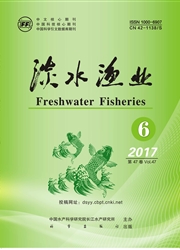

 中文摘要:
中文摘要:
采用人工受精获得的南方鲇 Silurus meridionalis Chen胚胎和仔鱼为实验对象,以Pb(NO3)2为毒物源,在水温22.5℃条件下,观察了水体中不同质量浓度铅(Pb)暴露对南方鲇胚胎孵化率、畸形率、自主运动、孵化历时的影响,并进行了初孵仔鱼的Pb暴露毒理实验.实验结果表明,在水体中Pb2+质量浓度分别为0(对照),4,8,12和16 mg/L的条件下,南方鲇胚胎孵化率随着Pb质量浓度的上升呈下降趋势,分别为84.94%,71.23%,69.75%,66.57%和64.69%,各Pb质量浓度处理组的孵化率显著低于对照组( p<0.05);且孵出的仔鱼出现心包水肿,脊柱弯曲以及尾巴弯曲退化等畸形特征,畸形率随着 Pb质量浓度的升高呈上升趋势,分别为10.27%,15.28%,22.28%和36.67%,各Pb暴露组均显著高于对照组(2.37%)( p<0.05);各Pb质量浓度暴露组胚胎在出膜前期的自主运动频率分别为63.86,52.71,48.43和47.14次/min均显著低于对照组(78.00次/min)(p<0.05);各Pb质量浓度暴露组的胚胎孵化历时均显著长于对照组(p<0.05).孵化后在净水(未加入Pb(NO3)2的实验水体)中养殖的卵黄囊期仔鱼72 h死亡率随着其胚胎期Pb暴露质量浓度的上升呈上升趋势,胚胎期Pb暴露质量浓度分别为0,4,8,12和16 m g/L的条件下,仔鱼期的净水死亡率分别为9.45%,18.22%,20.95%,24.05%和26.29%,胚胎期各Pb质量浓度暴露组所获仔鱼的死亡率均显著高于对照组( p<0.05).根据水体 Pb暴露对南方鲇初孵仔鱼急性中毒致死的观测结果推算,其96 h半致死质量浓度(96 h LC50)为0.32 mg/L .本研究结果表明,南方鲇胚胎对水体Pb暴露的耐受性高于其初孵仔鱼,可能与南方鲇的受精卵卵膜较厚,对水体中的Pb2+进入胚胎具有较大的阻滞作用有关.
 英文摘要:
英文摘要:
To determine the toxic effects of waterborne Lead (Pb) on embryonic and larval development of the southern catfish (Silurus meridionalis Chen) ,the embryos and larvae which have been bred with arti-ficial fertilization have been exposed to Pb solutions of five nominal concentrations (0 ,4 ,8 ,12 and 16 mg/L) at 22 .5℃ respectively .Embryonic hatching rate ,larval malformation rate ,spontaneous movements , incubation period have been evaluated at the end of embryonic period . Acute toxicity of Pb to newly hatched larvae has also been determined in this study .Embryonic hatchability has decreased with the in-creasing Pb concentration .The value in the groups of 4 ,8 ,12 and 16 mg/L were 71 .23% ,69 .75% ,66 .57%and 64 .69% respectively ,which are significantly lower compared with the control group (84 .94% ) (p〈0 .05) .Furthermore ,exposure of embryos to Pb has significantly increased morbidity of body malforma-tions in newly hatched larvae ,such as pericardial edema ,body curvature and degenerated tail .In the groups of 4 ,8 ,12 and 16 mg/L ,the malformation rate of newly larvae are 10 .27% ,15 .28% ,22 .28%and 36 .67% respectively ,which are significantly lower than that of the control group (2 .37% ) (p〈0 .05) .The average spontaneous movements of embryos decreased along the contamination gradient .In the concentrations of 4 ,8 ,12 and 16 mg/L ,the value are 63 .86 ,52 .71 ,48 .43 and 47 .14 beats/min , which are significantly lower compared with the control group (78 .00 beats/min) before hatching (44 hours post-fertilization) (p〈0 .05) .Pb also has an inhibitory effect on hatching time .The incubation peri-ods are significantly delayed compared to control (p〈0 .05) .Exposures to waterborne Pb during embryon-ic period alone causes adverse impact on larval performance even w hen larval development took place in clean w ater .And the lowest larval mortality in 72 hours after hatching occurred in the control group (9 .45% ) , which is significantly lower th
 同期刊论文项目
同期刊论文项目
 同项目期刊论文
同项目期刊论文
 期刊信息
期刊信息
